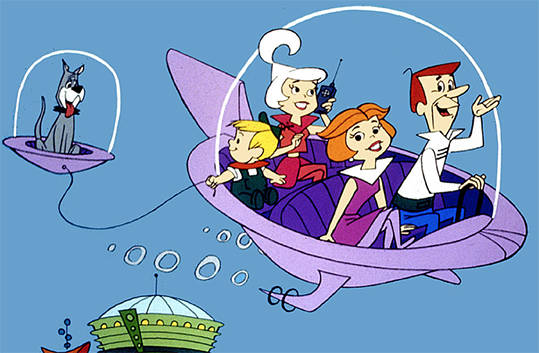Dear Elon: The Tesla in Space was a Great Idea
But we need to make it real

Editor’s note: this essay is the second in an ongoing series advocating for Elon Musk to return to his core areas of competency developing groundbreaking technologies rather than wasting his time making social media worse. See the first installment here:
George Jetson could never have been a cool Dad without his flying car. Cowboy Bebop’s Spike Spiegel would have been lost without his Swordfish, Star Wars would have been hopeless without X-Wings. In fiction and in our dreams, our best and brightest future involves flying cars in space.
This used to be just a dream - but Space X tech can make it happen
A plane that can launch from Earth (or a spot with a similar gravitational pull), rise into orbit, and return safely back home has been the Holy Grail of Aerospace design for almost a century. There have been many attempts to find a workable design (the 1930's Silbervogel, the HL-10, NASA's Rockwell X-30) But all were stymied by similar problems - the difficulty of breaking away from Earth's gravity and the fuel vs. weight conundrum.
To travel beyond Earth’s atmosphere and gravitational forces a rocket or powered ship needs to reach “escape velocity” (approx. 25,000 mph.) To do that, it needs a lot of fuel, which makes the whole contraption heavier. To generate lift, a heavier plane needs more fuel. Rockets get around this by putting the necessary fuel into “boosters” and dumping them after the “escape” fuel is used up. As the atmosphere gets thinner and friction is lowered, the rocket only needs a small amount of energy to travel and stay in orbit. This process is called “staging.” It's what most of the industry uses today.
Spaceplanes that don’t use the same process need workarounds. The Silbervogel and the HL-10 got around it by using wings to generate lift and lighter materials in their construction. This “lifting bodies” construction reduced the need for more propellant.
NASA’s X-30 used a supersonic combustion ramjet (scramjet) as part of its propulsion system. This replaced the oxidizer used in traditional staging, but it still had to switch back to a more traditional rocket engine as the plane moved through the thinner atmosphere at higher altitudes.

Unfortunately, getting into orbit was only half the problem. Returning to Earth was more difficult.
Getting back home
Spacecraft reentry is tricky. Gravity will naturally pull the craft back to Earth but gravity will make it fall dangerously fast. The particles of air in Earth's atmosphere will slow the fall by creating friction via air resistance. This slows the craft down to a safer entry speed but it also causes intense heat. (about 3000º F, or 1649º C). The standard blunt-body design of most space capsules, with its wide, flat bottom surface & protective heat shield, helps alleviate the heat problem by creating a shock wave that keeps the heat at a distance from the actual craft while slowing its fall.
That won't work for a spaceplane. A more elegant craft requires a more elegant return - the skip re-entry.
A skip re-entry needs real precision. The ship has to hit a small target a little more than a dozen miles wide at just the right angle. Too sharp, and the craft is incinerated; too shallow, and it bounces off the atmosphere and back into space.
NASA flight engineers thought about attempting skip re-entries during the Apollo program, but the lack of advanced computer modeling or an onboard guidance computer made the tricky maneuver too risky.
They didn't have that technology then, but we have it now. The skip-re-entry was already tested when NASA’s Orion returned to Earth at the end of the Artemis I mission. The flight engineers were able to precisely rotate the capsule during its descent to deliberately pull off an atmospheric bounce. This reduced the g-force experienced on board from 6.8 to 4, cooled the heat shield and increased the target window for what NASA called an "historic reentry."
Space planes are not just fun, they're practical
Robert Zubrin, American aerospace engineer, author, and advocate for human exploration of Mars says,
"If travel to orbit is ever to be as cheap as air travel, we will need a worldwide infrastructure that supports not hundreds of flights per year, but hundreds of flights per day. The only market that can support that kind of development is global long-distance surface to surface passenger travel - like it or not, a lot more people want to go to Tahiti than want to go to orbit. If you want to serve that market, you want to use winged rocket planes .. because trillions of dollars worth of infrastructure is available all over the world - in the form of existing airports and surrounding facilities - to support their operation."
If properly developed, winged rocket planes might supplant traditional rockets as a way of getting into space, in the same way that airplanes supplanted airships.
Some companies, like the Washington-based Radian Aerospace are already looking into this “alluring concept”. It could be a new hope.






